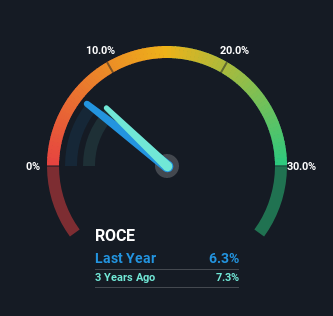Returns On Capital Signal Difficult Times Ahead For Steamships Trading (ASX:SST)
What underlying fundamental trends can indicate that a company might be in decline? Businesses in decline often have two underlying trends, firstly, a declining return on capital employed (ROCE) and a declining base of capital employed. This indicates to us that the business is not only shrinking the size of its net assets, but its returns are falling as well. On that note, looking into Steamships Trading (ASX:SST), we weren't too upbeat about how things were going.
What is Return On Capital Employed (ROCE)?
For those that aren't sure what ROCE is, it measures the amount of pre-tax profits a company can generate from the capital employed in its business. The formula for this calculation on Steamships Trading is:
Return on Capital Employed = Earnings Before Interest and Tax (EBIT) ÷ (Total Assets - Current Liabilities)
0.063 = K83m ÷ (K1.5b - K199m) (Based on the trailing twelve months to December 2021).
Thus, Steamships Trading has an ROCE of 6.3%. In absolute terms, that's a low return but it's around the Industrials industry average of 7.7%.
Check out our latest analysis for Steamships Trading
Historical performance is a great place to start when researching a stock so above you can see the gauge for Steamships Trading's ROCE against it's prior returns. If you'd like to look at how Steamships Trading has performed in the past in other metrics, you can view this free graph of past earnings, revenue and cash flow.
The Trend Of ROCE
There is reason to be cautious about Steamships Trading, given the returns are trending downwards. About five years ago, returns on capital were 9.5%, however they're now substantially lower than that as we saw above. Meanwhile, capital employed in the business has stayed roughly the flat over the period. This combination can be indicative of a mature business that still has areas to deploy capital, but the returns received aren't as high due potentially to new competition or smaller margins. If these trends continue, we wouldn't expect Steamships Trading to turn into a multi-bagger.
The Key Takeaway
In summary, it's unfortunate that Steamships Trading is generating lower returns from the same amount of capital. Investors haven't taken kindly to these developments, since the stock has declined 46% from where it was five years ago. Unless there is a shift to a more positive trajectory in these metrics, we would look elsewhere.
One more thing to note, we've identified 1 warning sign with Steamships Trading and understanding it should be part of your investment process.
While Steamships Trading may not currently earn the highest returns, we've compiled a list of companies that currently earn more than 25% return on equity. Check out this free list here.
Have feedback on this article? Concerned about the content? Get in touch with us directly. Alternatively, email editorial-team (at) simplywallst.com.
This article by Simply Wall St is general in nature. We provide commentary based on historical data and analyst forecasts only using an unbiased methodology and our articles are not intended to be financial advice. It does not constitute a recommendation to buy or sell any stock, and does not take account of your objectives, or your financial situation. We aim to bring you long-term focused analysis driven by fundamental data. Note that our analysis may not factor in the latest price-sensitive company announcements or qualitative material. Simply Wall St has no position in any stocks mentioned.

 Yahoo Movies
Yahoo Movies 
